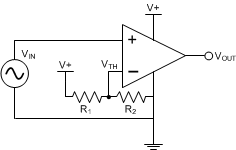SBOSAJ4 June 2024 TLV9304-Q1
PRODMIX
- 1
- 1 Features
- 2 Applications
- 3 Description
- 4 Pin Configuration and Functions
- 5 Specifications
- 6 Detailed Description
- 7 Application and Implementation
- 8 Device and Documentation Support
- 9 Revision History
- 10Mechanical, Packaging, and Orderable Information
7.2.1 High Voltage Precision Comparator
Many different systems require controlled voltages across numerous system nodes to ensure robust operation. A comparator can be used to monitor and control voltages by comparing a reference threshold voltage with an input voltage and providing an output when the input crosses this threshold.
The MUX-friendly input stage of TLV930x-Q1 op amp family allow designers to use these devices as high voltage comparators (see Input Protection Circuitry). Previous generation high-voltage op amps often use back-to-back diodes across the inputs to prevent damage to the op amp, which greatly limited a designer's capability to use these op amps as comparators. The patented input stage of the TLV930x-Q1, however, allows the device to have a wide differential voltage between the inputs.
 Figure 7-1 Typical Comparator Application
Figure 7-1 Typical Comparator Application